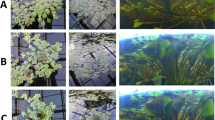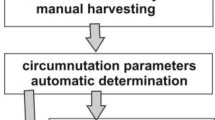Abstract
Modulation of a turgor-growth movement called circumnutation in sunflower (Helianthus annuus L.) was investigated using a picture analysis system. Two photoperiod conditions were applied: light–darkness conditions (LD) 8:8 and LD 20:10. After about 3 weeks of these regimes, the plants were placed under constant light to determine whether circadian regulation of circumnutation existed or not. The rhythms of movement activity with regard to the trajectory length, period, and shape of individual circumnutations were examined. Data were processed by Fourier spectral analysis. All the parameters, trajectory length, period, and shape, revealed the ability to entrain to the administered daily cycles (16 h or 30 h). We observed diurnal fluctuations of the circumnutation parameters with the phase of the highest trajectory length, the shortest period, and the highest shape coefficient (the most circular form) during the dark period. After the LD–LL transition, the parameters revealed periodicity, which was close to 24 h. After several days of a clear circadian free running rhythm, a gradual decrease of the amplitude of the rhythm was observed. However, the rhythm did not disappear completely. The trajectory length manifested the strongest entrainment; the circumnutation period and the circumnutation shape were less modulated by photoperiod. These findings indicate for the first time that different parameters of circumnutation in sunflower are circadian-regulated rhythms, not solely ultradian as had been thought previously.




Similar content being viewed by others
References
Badot PM, Melin D, Garrec JP (1990) Circumnutation in Phaseolus vulgaris L. II. Potassium content in the free-moving part of the shoot. Plant Physiol Biochem 28:123–130
Brown AH, Chapman DK (1984) Circumnutation observed without a significant gravitational force in spaceflight. Science 225:230–232
Brown AH (1993) Circumnutations: from Darwin to space flights. Plant Physiol 101:345–348
Buda A, Zawadzki T, Krupa M, Stolarz M, Okulski W (2003) Daily and infradian rhythms of circumnutation intensity in Helianthus annuus L. Physiol Plant 119:582–589
Caré AF, Nefed’ev L, Bonnet B, Millet B, Badot PM (1998) Cell elongation and revolving movement in Phaseolus vulgaris L. twining shoots. Plant Cell Physiol 39: 914–921
Comparot S, Morillon R, Badot PM (2000) Water permeability and revolving movement in Phaseolus vulgaris L. twining shoots. Plant Cell Physiol 41:114–118
Cosgrove DJ (2000) Expansive growth of plant cell walls. Plant Physiol Biochem 38:109–124
Darwin CA, Darwin F (1880) The Power of Movement in Plants. John Murray, London
Engelmann W, Johnsson A (1998) Rhythms in organ movement. In: Lumsden PJ, Millar AJ (eds) Biological Rhythms and Photoperiodism in Plants. Oxford University Press, BIOS, Oxford, England, United Kingdom pp 35–50
Farner DS, King JR (1975) Avian Biology, Academic Press, vol. 5, pp 234–250
Giboz D, Badot PM, Millet B (1995) Involvement of calcium ions in circumnutation of twining shoots. Biol Cell 84:102
Hashimoto T (2002) Molecular genetic analysis of left-right handedness in plants. Phil Trans R Soc Lond B 357:799–808
Hatakeda Y, Kamada M, Goto N, Fukaki H, Tasaka M, et al (2003) Gravitropic response plays an important role in the nutational movements of the shoots of Pharbitis nil and Arabidopsis thaliana. Physiol Plant 118:464–473
Hayashi Y, Nishiyama H, Tanoi K, Ohya T, Nihei N, et al (2004) An aluminum influence on root circumnutation in dark revealed by a new super-HARP (high-gain avalanche rushing amorphous photoconductor) camera. Plant Cell Physiol 45:351–356
Hejnowicz Z, Sievers A (1996) Acid-induced elongation of Reynoutria stems requires tissue stresses. Physiol Plant 98:345–348
Johnson CH, Elliott J, Foster R, Honma K, Kronauer R (2004) Fundamental properties of circadian rhythms. In: Dunlap JC, Loros JJ, DeCoursey PJ (eds) Chronobiology—Biological Timekeeping. Sinauer Asssociates, Sunderland, Massachusetts, USA, pp 67–107
Johnsson A (1979) Circumnutations. In: Haupt W, Feinleib ME, (editors) Encyclopedia of Plant Physiology. Physiology of Movements. Springer-Verlag, Berlin, Germany 7:627–646
Johnsson A (1997) Circumnutations: results from recent experiments on Earth and in space. Planta 203:147–158
Johnsson A, Jensen C, Engelmann W, Schuster J (1999) Circumnutations without gravity: a two oscillator model. J Gravitational Physiol 6:9–12
Jouve L, Greppin H, Degli Agosti R (1998) Arabidopsis thaliana floral stem elongation: evidence for an endogenous circadian rhythm. Plant Physiol Biochem 36:469–472
Jouve L, Gaspar T, Kevers C, Greppin H., Degli Agosti R (1999) Involvement of indole-3-acetic acid in the circadian growth of the first internode of Arabidopsis. Planta 209:136–142
Lubkin S (1994) Unidirectional waves on rings: models for chiral preference of circumnutating plants. Bull Math Biol 56:795–810
McClung CR (2000) Circadian rhythms in plants: a millennial view. Physiol Plant 109:359–371
Millet B, Badot PM (1996) The revolving movement mechanism in Phaseolus: new approaches to old questions. In: Greppin H, Degli Agosti R, Bonzon M (eds) Vistas on Biorhythmicity. University of Geneva, Geneva, Switzerland pp 77–98
Millet B, Melin D, Badot PM (1988) Circumnutation in Phaseolus vulgaris L. I. Growth, osmotic potential and cell ultrastructure in the free-moving part of the shoot. Physiol Plant 72:133–138
Nardini A, Salleo S, Andri S (2005) Circadian regulation of leaf hydraulic conductance in sunflower (Helianthus annuus L. cv. Margot). Plant Cell Environ 28:750–759
Niinuma K, Someya N, Kimura M, Yamaguchi I, Hamamoto H (2005) Circadian rhythm of circumnutation in inflorescence stems of Arabidopsis. Plant Cell Physiol 46:1423–1427
Salomé PA, McClung CR (2005) What makes Arabidopsis clock tick on time? A review on entrainment. Plant Cell Environ 28:21–38
Schuster J, Engelmann W (1997) Circumnutations of Arabidopsis thaliana seedlings. Biol Rhythm Res 28:422–440
Shabala S (2003) Physiological implications of ultradian oscillations in plant roots. Plant Soil 255:217–226
Trębacz K, Stolarz M, Dziubińska H, Zawadzki T (1997) Electrical control of plant development. In: Greppin H, Penel C, Simon P (eds) Travelling Shot on Plant Development. Geneva, Switzerland, University of Geneva pp 165–181
Vanden Driessche T (2000) Nutations in shoots and in Desmodium lateral leaflets, nyctinastism and seismonastism in Mimosa pudica. Comparison and evolution of morphology and mechanism. Biol Rhythm Res 31:451–468
Webb AAR (2003) The physiology of circadian rhythms in plants. New Phytologist 160:281–303
Yoshihara T, Iino M (2005) Circumnutation of rice coleoptiles: its occurrence, regulation by phytochrome, and relationship with gravitropism. Plant Cell Environ 28:134–146
Acknowledgments
This work was supported by the Polish State Committee for Scientific Research. Special thanks to Eric Davies for his essential and linguistic support.
Author information
Authors and Affiliations
Corresponding author
Rights and permissions
About this article
Cite this article
Charzewska, A., Zawadzki, T. Circadian Modulation of Circumnutation Length, Period, and Shape in Helianthus annuus . J Plant Growth Regul 25, 324–331 (2006). https://doi.org/10.1007/s00344-006-0042-5
Received:
Accepted:
Published:
Issue Date:
DOI: https://doi.org/10.1007/s00344-006-0042-5




